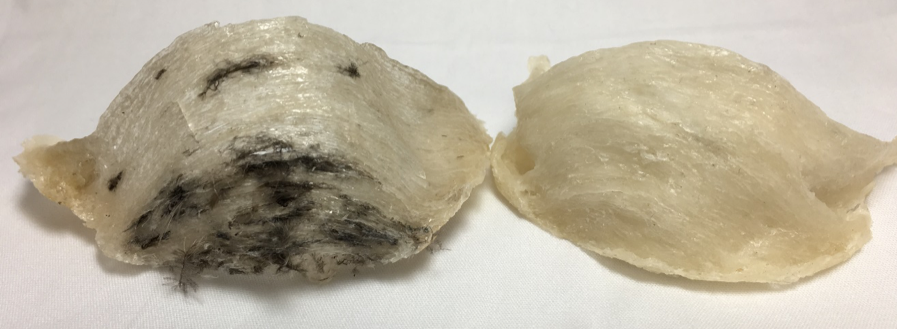- How are edible bird’s nests built?
Edible bird’s nestor yan wois formed from the solidified salivary secretions of a few selected species of swiftlets. Majority of edible bird’s nest come from two species under the genus of Aerodramus: the white-nest swiftlet (Aerodramus fuciphagus) and the black-nest swiftlet (Aerodramus maximus). These two species produce edible nests with fewest impurities and have higher commercial values. Most Aerodramusswiftlets live in habitats from the regions ofthe Nicobar Islands in the Indian Ocean, to sea caves in the coastal regions of Thailand, Vietnam, Indonesia, Borneo, and the Philippines. During the breeding season, swiftlets secrete a largeamount of mucin from the sublingual glands. Mucin is bound together with feathers and permeated with other materials, such as plant material. The structure hardens after the bird has shaped it into a solid half bowl-shaped nest to bear the nestlings.
- Processing of bird’s nest
Raw bird’s nests are collected and sent for cleaning after the breeding season. The cleaning process is highly labor-intensive and time-consuming. The raw nest is soaked in water until the nest cement has softened and expanded. The interwoven feathers, fine plumage, eggshells, sand particles, andany other impurities are manually removed with tweezers. Following that, the cleaned moistened strands of nest cement are rearranged and molded into a cup, biscuit or other shapes, then air-dried to obtain a cleaned bird’s nest product which is marketable. The bird’s nest are then packaged in elegant lacquer boxes or as ready-to-drink bottled drinks for sale all over the world.
- Historical consumption of bird’s nest
Human consumption of bird’s nest soup has historically been a symbol of wealth, prestige, and power. Bird’s nest also has medicinal value in Chinese medicine. The consumption of bird’s nest as a quintessential delicacy in ancient China can be traced back to the TangDynasty (618-907 AD) where bird’s nest soup was served to Empress Wu Zetian by her royal chef. History classics stated that Admiral Zheng He brought back bird’s nest to the imperial court of Ming Dynasty (1368-1644 AD) as a tributefrom his voyage to the South China Sea. The existence of bird’s nest has also been reported in Chinese literature from the MingDynasty and Qing Dynasty (1636-1912 AD). Subsequently, this delicacy was brought from China into prominence to western countries in the 19thcentury. Nowadays, the consumption of bird’s nest is no longer a privilege for the wealthy. Various ready-to-drink bottled bird’s nests are appearing in supermarkets and shops across the world, and the benefits of bird’s nest are increasingly being promoted to domestic consumers.
- What bird’s nest is made of
The main constituents of bird’s nest are glycoproteins, which are substances with properties of both proteins and carbohydrates. In addition to glycoprotein, bird’s nest also contains moisture, minerals and a trace amount of lipids. Research has shownthat amino acids (both essential and non-essential) in bird’s nest are found at a higher concentration than typical protein-rich food like milk and eggs. Hence, bird’s nest has been suggested to be a premium grade protein-source supplement. Nutritionally, bird’s nest contains numerous components with a high nutritional value to the human body.
- House & cave bird’s nests
In the natural environment, swiftlets cling to rock ceilings of limestone caves and weave palm-sized nests to lay their eggs. As nests are usually attached to elevated, vertical concaved cave walls, harvesting cave nests involves dangerous nest retrieval work. In the last few decades, human begun to design and build concrete structures called “bird’s houses” to attract swiftlets. Swiftlets are enticed to the buildings by amplified recordings of birds’ chirping sounds. They then build nests on planks of thick wood beams attached to the ceilings. Nests collected from natural caves are known as “cave nests”, and those collected from bird’s houses are known as “house nests”. At present, minor differences are known to exist in the nutritional value and composition between house and cave nests. Cave nests have slightly higher mineral content, due to leeching of minerals from limestone walls, and require a more extensive cleaning process to remove impurities.
- White & red bird’s nest
Bird’s nest sold on the market are usually white in color. However, yellow or red bird’s nests can also be found and are much sought after in the marketplace. In earlier times, numerous conjectures on the red coloration had been proposed: coloration by blood spat from exhausted swiftlets (thereby referred to as ‘blood’ nest or xueyan), oxidation, or minerals absorbed from the environment. However, recent research has revealed that red bird’s nest does not contain blood, and is also unlikely due to minerals that are present. Instead, it has been shown that a chemical reaction (known as “nitration”) of bird’s nest mucin glycoprotein, by reactive nitrogen species, produces red colored molecules in glycoprotein. This nitration reaction is the true cause of the red coloration. Interestingly, research has shown that it is white-coloured bird’s nests that can remove reactive nitrogen species effectively by undergoing nitration. As the ability to remove reactive nitrogen species in the body is considered beneficial to health, the belief that red bird’s nest is superior to white bird’s in terms of health benefit is likely to be incorrect.
- Traditional & modern scientific benefits of eating bird’s nest
Bird’s nest is believed by many people (mainly Chinese) to have rejuvenating and cosmetic virtues. Practitioners of Chinese medicine have consistently recommended the consumption of bird’s nest for various health problems. It is reputed to possess medicinal properties that nourishes and tones up the organ systems of the body, helps to dissolve phlegm, speeds up recovery from health issues, relieves gastric problems, aids kidney function, enhances complexion, alleviate asthma, suppresses chronic coughing, cures tuberculosis, and relieves fatigue. In the last few decades, the medicinal effect of bird’s nest has been investigated using modern scientific methods. Early research suggest anti-influenza properties against influenza viruses, cognitive-enhancing properties in memory and learning ability, anti-oxidative properties, ability of lowering risk of cardiovascular disease, skin-whitening properties, and others. Newer benefits elucidated by modern science will continue to be uncovered, as the field of bird’s nest research continues to develop.
Reference
Chua, Y. G.; Chan, S. H.; Bloodworth, B. C.; Li, S. F. Y.; Leong, L. P., Identification of Edible Bird’s Nest with Amino Acid and Monosaccharide Analysis. Journal of Agricultural and Food Chemistry 2015,63(1), 279-289.
Marcone, M. F., Characterization of the edible bird’s nest the “Caviar of the East”. Food Research International 2005,38(10), 1125-1134.
Shim, E. K.-S.; Lee, S.-Y., Nitration of Tyrosine in the Mucin Glycoprotein of Edible Bird’s Nest Changes Its Color from White to Red. Journal of Agricultural and Food Chemistry 2018,66(22), 5654-5662.
Wong, R. S. Y., Edible bird’s nest: Foodormedicine? Chinese Journal of Integrative Medicine2013,19(9), 643-649.

